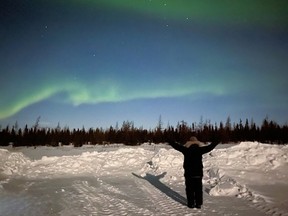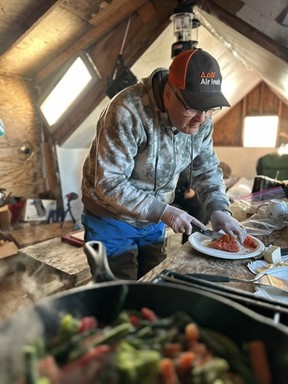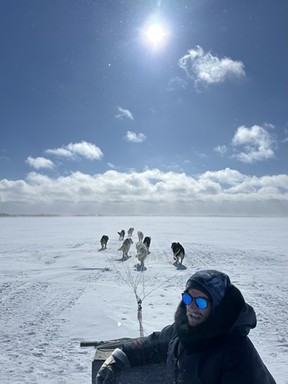Reviews and recommendations are unbiased and products are independently selected. Postmedia may earn an affiliate commission from purchases made through links on this page.



Remote Kuujjuaq is vast and beautiful
Reviews and recommendations are unbiased and products are independently selected. Postmedia may earn an affiliate commission from purchases made through links on this page.
It’s hard to predict the weather when you’re travelling to Canada’s northern reaches and I couldn’t help feeling a little apprehensive when the plane touched down in Nunavik, Que., in near-whiteout conditions. I had long dreamt of visiting this remote and remarkable place hoping to go dogsledding and snowmobiling across the tundra, see muskox in the snow and view the northern lights under the auroral oval — all of which would be nearly impossible to do in poor weather. I consoled myself with the thought that I had six days for the weather to change.
Advertisement 2
Article content
Kuujjuaq is the largest village in Nunavik, a region in northern Quebec that sits at the place where the treeline meets the vast ice-encrusted tundra, a landscape so harsh it was never colonized by European settlers, though it was the site of a Hudson’s Bay outpost and a U.S. military base during the Second World War. This is the traditional territory of the Inuit who continue to survive and thrive while struggling to maintain their traditions and keep their culture alive as the climate warms and the outside world comes ever closer.
It’s a place that is almost impossible to explore on your own, so my husband and I did it with the help of Allen Gordon, a longtime community member and a guide with Nunawild (nunawild.com). Our guide didn’t seem worried at all when we met him for our first day of exploring. Adapting to weather conditions is part of everyday life in Nunavik.
Article content
Advertisement 3
Article content

Since it wasn’t safe to head out onto the tundra, Gordon showed us sites in and around Kuujjuaq, a community of about 2,700 people that is the capital of this region and is considered a big city by Inuit standards.
Our first stop was just outside the village at a place Gordon called the breakwater which sits across from the old Hudson’s Bay trading post. It is also the place on the Koksoak River where the ice turns to water. Today the open water area lies near the old trading post, but that wasn’t always the case.
“I remember driving my dogsled across the ice here when it was at least a metre thick,” Gordon said. “No one dares to cross this ice now.” When I started to walk toward some interesting ice formations near the shoreline, Gordon called me back. “You never know where a polar bear might be hiding,” he explained. “We had one in town a couple of weeks ago.”
Advertisement 4
Article content
Anyone who doubts that global warming is real should visit this place and see for themselves. Melting ice and the presence of polar bears are both signs of a warming climate. As the ice melts and their hunting season shortens, polar bears are venturing further inland to places like Kuujjuaq, which is about 50 kilometres upstream from Ungava Bay.
Our time in the community offered a fascinating glimpse into local culture. Inuit peoples have survived for thousands of years in harsh conditions with a culture of sharing, and this is still evident today in places like the community sewing centre, the carpentry centre and the community freezer that we visited.
The community sewing centre and the carpentry centre help youths and adults learn traditional ways living, so they can embrace their culture and be proud of who they are. Both were buzzing with activity — men building sleds to pull behind their snowmobiles and women sewing clothing and kamiks, a traditional type of footwear. “We had a kamik-making workshop last January that lasted about three weeks,” explained Christina Kleist, the sewing centre’s co-ordinator. “We prepared, softened the seal skins, cut out the patterns of the kamik and sewed them. There were 30 participants and 28 of them finished their projects.”
Advertisement 5
Article content
We also visited the community freezer that supplies Inuit community members with caribou meat, the staple of the traditional diet. The community also stocks the freezer with fish from time to time. The community freezer is free to all Inuit in the community.
Through a translator, we spoke to Johnny Gordon, an Elder who had lived the traditional nomadic way of life, and we attended a throat singing performance by Janice Parsons and Sandy Emudluk in the cultural centre. Throat singing is one of the ways Inuit women in Arctic Canada and Alaska entertained themselves and family members during long dark winter nights. The songs are a guttural kind of sound and a competition between partners to see who will laugh first. Since Parsons loves to laugh, Emudluk usually wins.
Advertisement 6
Article content

When the blowing snow subsided and the sun finally came out, we went out on the tundra on snowmobiles getting closer to the vast and beautiful landscape. We experienced dogsledding the Inuit way — with the dogs on a fan hitch that our dogsledding guide, Sheldon Whiteley, said is easier to manage when he travels along the treeline. We watched a snowmobile race, saw wild muskox in the snow, ate caribou that our guide prepared and one evening we gazed in awe at the glowing green lights of the aurora borealis swirling and twirling through the stars.
We were fortunate to be able to fit in all the activities we had originally planned, but in the end, I was grateful for the bad weather we experienced at the beginning of the trip. It gave us the chance to meet locals and learn more about Inuit culture than we would have otherwise, and that is the real highlight of visiting Nunavik.
Debbie Olsen is an award-winning Métis writer and a national bestselling author. Follow her adventures at wanderwoman.ca.
Article content